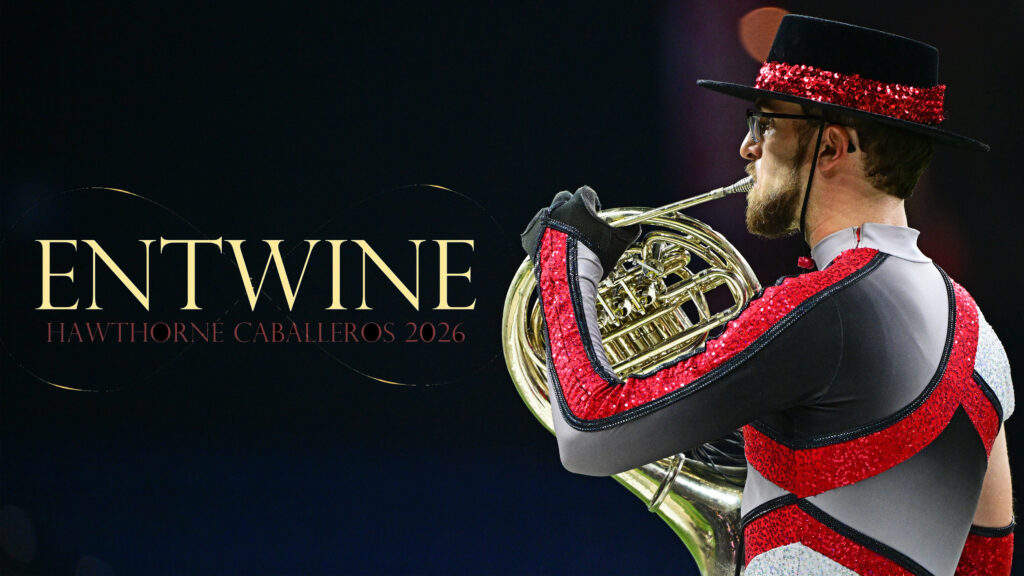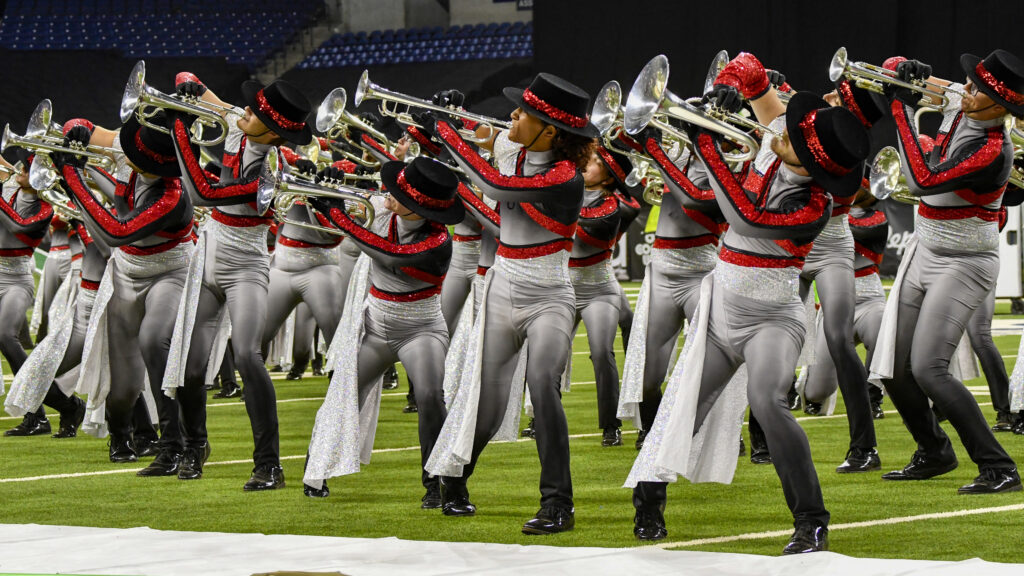Harold Craig Barber submitted the following in honor of Black History Month.
Black History Month represents a unique perspective to celebrate—as well as educate—others on the contributions to our country of African-Americans. I can only image what it must to have been like for African-American drum corps to venture and compete in areas where they likely weren’t even welcomed before and during our country’s Civil Rights movement—not to mention those individuals who tried to integrate drum corps when there was no welcome mat out for African-American kids. Despite those odds, black communities produced a lot of excellent and proficient drum and bugle corps.
As I scan some of the faces of African-American young people participating in drum corps today, I’m quite sure they have no knowledge of the once vibrant drum and bugle corps activity that flourished in black communities across the country. No history or heritage has been passed down to this generation of marchers. I think about the African-American drum corps icons of my era; Eugene Bennet, Billy Cobham, Bill Hightower, Sol Anthony and Bobby Winslow, just to name a few. I think about my young instructors from Carter Cadets who taught me the proper way to play snare drum.
I’m a New York City public schoolteacher. I reminisce about my junior high teacher Mr. Johnson. He started a drum and bugle corps in our school called the Decatur Cadets. He saw the importance of getting kids involved in this activity. I wish I could thank him for his commitment to kids. The activity did a lot of shaping us into fine adults.
A few years back, I had a conversation with my lifelong friend Herschel Vaughn about the decline in numbers of the once-plentiful community based African-American drum corps. We concluded that the drum and bugle corps experience had bypassed a lot of African-American children and its once great notoriety in our community had died out.

When I think about how African-American drum and bugle corps once permeated the inner city landscape, I ponder how a much loved activity in my community dried up over the years. As I look at young people in my community, I reminisce about the Carter Cadets, Warriors, Wynn Center Toppers, Riversiders, Page Park Cadets and the Washington VIPs. I wished these young people had the same opportunities to experience the drum and bugle corps activity as I did.
I live by the once-occupied old Carter Cadets building located in the Bedford-Stuyvesant section of Brooklyn and pass it frequently. I can almost see members milling around outside. I look at the top floor where the drum line once rehearsed. A car repair shop resides where the horn line once practiced on the main floor. It is kind of a sad testament to a once glorious past.
I remember us marching back to our headquarters in 1969. We had just finished doing the Brooklyn Day parade. We seemed to be the Piped Piper of Hamlin Town, because a throng of people followed us back to our building. Once there, it was an ocean of people waiting for us to perform our repertoire. I have never felt so proud in all my life. It was a great day to be a Carter Cadet. Being in a top drum and bugle corps back then was equivalent to be being a major recording star, especially where I lived. This was evident when people walked through the community with their corps jacket on. People would stop and ask us questions about how the corps did, when and where we rehearsed, where was the next contest, and how could one join the corps.
I really didn’t notice much about the decline of African-American drum corps after I aged out of drum corps. I was in college and pursued other endeavors. When I marched senior corps with the New York Skyliners, I still didn’t pay much attention to the plight of the declining activity in my community. In New York City we still had the CMCC Warriors, NY Lancers and the Kips Bay Boys Club. I would see some of these corps at rehearsal at New York City’s Randall’s Island Stadium.
The CMCC Warriors fought hard to keep it going, but eventually broke up in the late 1980s. The corps represented the last of the African-American drum and bugle corps to reach national prominence. The others disbanded as the years went by. It is only recently that corps such as Spirit of Newark, Quest and the Brooklyn Cadets began to make headway into the activity. Our ranks in the drum and bugle corps were thin to say the least. Whatever was happening in the inner city of New York was surely happening in other inner cities across country…the drum and bugle corps activity was dieing in our communities.
A friend of mine made a comment that kids today are not interested in drum corps. I disagree. If you build it they will come. The churches that once produced many drum corps don’t do so anymore. It probably had a lot to do with the increasing expense that drum corps were incurring. This is disheartening, because a lot of African-Americans are still involved in the activity. We got our humble beginnings out of some local church parade corps.
I’m looking at kids in the African-American community today who have no idea that Drum Corps International even exists. Kids in my community do not know what a drum and bugle corps is. They don’t see corps marching through the community as I did when I was in junior drum corps. There is no local show for them to attend to watch a drum corps show. Almost every church in the black community or youth organization had some type of bugle or glockenspiel parade corps or standstill corps. Drum and bugle corps were a fabric of the African-American community back during the 1950s, 60s and 70s.
I remember going over my friend Frank Simpson’s house. He had Fleetwood records as well as copies of Drum Corps Digest, Eastern Review and Drum Corps News. However, it was the Drum Corps Digest issue that posted a shot of a bugle player from each top corps. The horn players were photographed standing at parade rest, in their resplendent cadet style uniforms. Those pictures filled me with desire to be a part of this wonderful activity. I wanted to wear this superb military style cadet uniform. Drums corps back then looked so cool and prestigious. I later got my chance to don such a great looking uniform.
I know I speak for a lot of inner city adults who marched in African-American drum corps when I say that the drum corps activity has shaped the person that I am today. It kept me safe and out of trouble from the mean city streets. I was taught discipline, punctuality, teamwork, esprit de corps, hard work and respect for flag and country. In drum corps we learned to function with one goal; to be the best we could be collectively. These same principles guide my life today. I’ve seen many of my childhood friends fall by the wayside over the years. They did not have the same support mechanisms that I had; God, church, family, good friends and drum and bugle corps.
As drum corps began to evolve and move away from our communities, churches, VFW and American Legion posts and other organizations that once supported and nurtured the activity left behind the African-American inner city kids. I was so caught up in pursuing my senior corps activities that it never occurred to me that I could—or should—be doing something to help give kids in my community the same experience drum corps had given me.
Who is to blame if kids today do not know that one-time African-American drum corps like Carter Cadets, Wynn Center Toppers, CMCC Warriors, Riversiders, Washington VIPS, Page Park Cadets and others were great African-American drum corps in their era? Who is going educate them about the contributions of these excellent corps?
Somehow, I do feel that as adults, we have failed the children … not just African-American children, but children who would benefit greatly from being in a drum and bugle corps. We complain about young people’s brash behavior and lack of respect for self, community, flag and country. Yet, we do not offer anything to them that might help change these negative actions.
I wish I had the budget the government uses for wasteful endeavors. I’d start a drum corps in almost every community across New York City. I would also make it affordable. And I’d take any kid regardless of if they had talent or not.
I decided to find people who share the same sentiment and have finally found such people. It is a long time coming, but I am trying to do something to help plant the seeds of growth. I’m currently involved in a new initiate to plant a new seed of growth for new drum and bugle corps. I believe in giving back that which was giving to me.
Hopefully, I can do that with this new endeavor, sharing my history as well as my experience. I was once told, “Out of a little ripple, comes a big wave.” I hope I have done that. I think Mr. Johnson would be proud, knowing that I was trying to do something positive for today’s youth as he did for others and I.
I do know that I will keep trying to remind people and educate them about the “Golden Age” of the African-American drum and bugle corps era. These drum and bugle corps excelled and were at the top of their game.
Editorial assistance by Michael Boo. Fanfare archives





